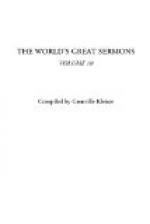II. The second fact in the human situation is that religion is the interpreter of man. As man looks backward he beholds beyond nature a face like his own, only diviner; and ever afterward the noblest aspiration of his soul is to win the smile of that face and to escape its frown. Our self-comprehending Adam would confess that he knew himself only when he noted within him the lover of the infinite. And here history leads the way. You look into “The Book of the Dead,” and you see what high and serious things religion meant for the early Egyptian. The pyramids are monuments to religion. The art of the ancient races was chiefly homage to the divine. The Athenian Parthenon would never have been but for faith in the goddess that shielded the city. Greek art, the greatest art in the world, is primarily a tribute to faith. Those marvelous statues were likenesses of the gods; those incomparable temples were dwelling-places for the gods. Religion is in the warp and woof of the world’s love and sorrow, its art and literature, its patriotism and history. The life of man is the cathedral window, and religion is the colored figure that stands in it. The two are inseparable. You can not abolish the figure without breaking the window; you can not banish religion without destroying humanity. Try to explain Homer’s world without Olympus; account for Mohammedanism and make no reference to faith; write the history of the Middle Ages and take no note of the “Divine Comedy”; sum up the meaning of Persian and Indian civilization and pay no heed to religion; show what Hebraism is and leave unnoticed its consciousness of God, and you will create a parallel to the philosopher who should endeavor to trace the significance of human life apart from man’s passion for the infinite.
Here then is the key to manhood. He is a being over whom the unseen wields an endless fascination. There is in him a thirst that nothing can quench save the living God. His chief attribute is an attribute of wo, an incapacity for content within the limits of the visible and temporal. His differentiation from the brute is at this point absolute. Between man and the lower orders of life there is a line of likeness; there is also from the beginning a line of unlikeness. In physical structure man is both similar and dissimilar to the animal. As bread-winner and economist he is kindred and he is in contrast to the creatures below him. In the home, in society, and in the state in which both home and society are set and protected, the line of likeness grows less and less distinct, while the line of unlikeness becomes bolder and plainer. It is impossible to deny observation to the dog and impossible to grant to it science. The instinct for beauty belongs to the bird, but art in the full sense of the word, as the self-conscious expression of beautiful ideas, is no part of its life. One can not decline to note method in the existence of the brute, and one is compelled to withold from




